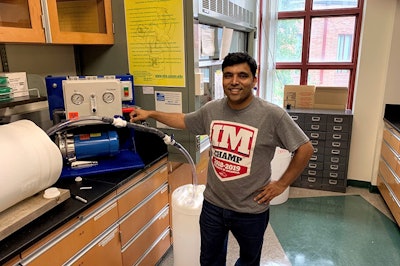
Two research projects at the University of Connecticut are investigating the potential of microbubbles as an antimicrobial wash against dangerous food pathogens on eggs and poultry.
“Our aim is to increase the antimicrobial efficacy of ozone by converting it into these ultra-fine bubbles that can stay in the solution for an extended duration to kill pathogens,” said Abhi Upadhyay, assistant professor of food microbiology and safety in the Department of Animal Science.
“Because of the small size of the bubbles, which are not visible to the naked eye but observable through diffraction technologies, we are able to have a higher concentration of ozone in the water.”
More than 48 million Americans get sick from a foodborne illness each year and 3,000 people die as a result, the Center for Disease Control and Prevention (CDC) estimates. Contaminated poultry meat is the underlying cause of 19% of deaths attributed to foodborne illnesses.
What are microbubbles?
Microbubbles, or ultra-fine bubbles, are small spherical, gas-filled cavities within liquids measuring less than 100 nanometers.
Their peculiar characteristics – high surface charge and gas pressure, taut inflexible surfaces, increased surface area and ability for prolonged survival in liquids – increase their usefulness in fields such as wastewater treatment, soil remediation and aquaculture.
For use in food wash, the researchers have filled the ultra-fine bubbles with ozone. Ozone is an antimicrobial gas commonly used for sterilization, deodorization and organic matter decomposition. It has a short life, decomposing to oxygen without any harmful residues left over.
More about the research projects
The first project is a three-year collaborative study on the use of ultra-fine ozone bubbles as an antimicrobial food wash on eggs and fresh produce. The research will test the solution’s effectiveness against Salmonella, Escherichia coli O157 and Listeria monocytogenes.
It is funded by a $184,874 grant from Northeast Sustainable Agriculture Research and Education. The research team includes Upadhyay, Assistant Extension Educator Shruresh Ghimire and Assistant Education Educator Indu Upadhyayaya.
For the second project, Upadhyay is working with Ghmire, Michael Darre, professor emeritus of animal science, Nathan Fiala, associate professor agricultural and resource economics, Ann Donoghue of the USDA Agricultural Research Service, Komala Arsi of the University of Arkansas, Anne Fanatico of Appalachian State University and Ondieki Gekara of CalPoly, Pomona. It is funded by a four-year, $500,000 grant from the United States Department of Agriculture (USDA).
“We are aiming to control Salmonella and Campylobacter, which are the two major foodborne pathogens transmitted through chicken meat,” Upadhyay said. “These two pathogens infect more than two million people with gastrointestinal disease every year.”
Like what you just read? Sign up now for free to receive the Poultry Future Newsletter.


















